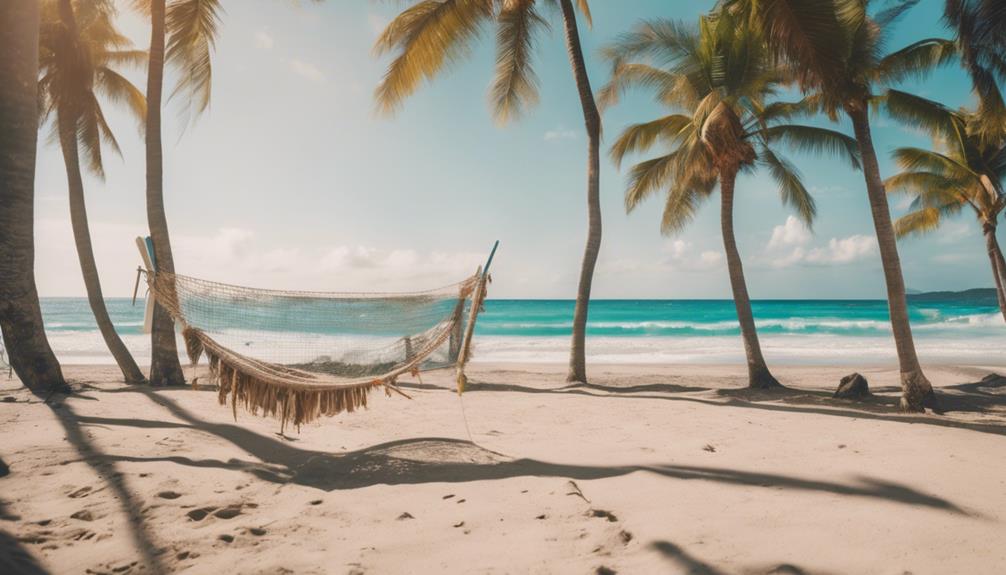To sail successfully, you should master essential knots like the bowline for loops, the clove hitch for quick securing, and the sheet bend for joining lines. The reef knot keeps lines tight, while the double fisherman’s knot handles heavy loads securely. For line adjustments, the rolling hitch is useful, and the figure-eight knot prevents slipping. Keep practicing these knots to boost your confidence and safety on the water—more tips await to enhance your skills further.
Key Takeaways
- Master the Bowline for secure loops and rescue situations.
- Learn the Clove Hitch for quick securing to cleats and posts.
- Use the Reef Knot for tying sails and bundling gear reliably.
- Practice the Sheet Bend to join lines of different sizes and materials.
- Know the Figure-Eight Knot as a safety stopper to prevent line slippage.
The Bowline: A Versatile Essential

The bowline is one of the most versatile and essential knots in sailing. It creates a secure loop that won’t slip or jam, making it perfect for attaching lines to objects or creating a reliable loop in a rope. You can use it to secure a halyard, form a rescue loop, or tie off a line quickly. Its key advantage is that it’s easy to tie and untie, even after bearing heavy loads or getting wet. To tie a bowline, make a small loop, then pass the end of the line through it, around the standing part, and back down through the loop. Practice makes perfect, and once mastered, you’ll find it invaluable for many sailing situations. Additionally, understanding the knot’s stability helps ensure safety and efficiency onboard. Learning about material durability can further enhance your ability to select appropriate ropes for different conditions.
The Clove Hitch: Quick and Secure Anchoring
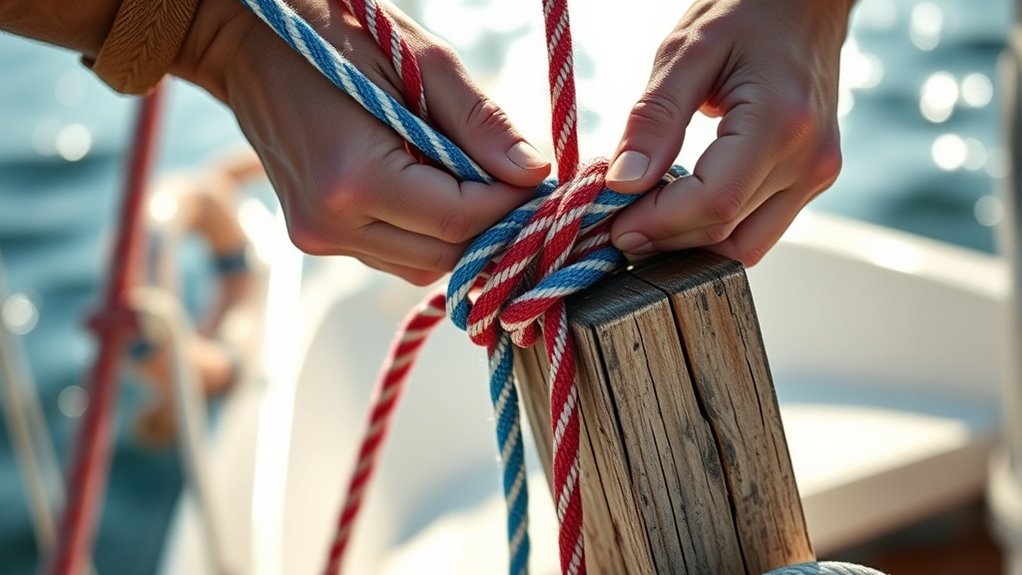
When you need a knot that’s both quick to tie and reliable for securing lines, the clove hitch is an excellent choice. It’s perfect for anchoring a line to a post, cleat, or bollard. To tie it, wrap the line around the object, then pass the working end over the standing part, creating two turns that cross over each other. Finish by tucking the end under the last wrap or around the object again. The clove hitch holds well under tension and is easy to adjust or untie quickly. It’s ideal for temporary mooring or securing sails. Just remember, if the load shifts or pulls unevenly, the knot can slip, so use it where tension is steady. Practice makes perfect, ensuring your knot remains secure when it counts. Additionally, understanding knot security can help you select the best knot for different situations. For added safety, consider how security zone info influences the choice of knots in various environments. Recognizing the appropriate knot for each situation can prevent accidents and improve your sailing safety. Being aware of environmental conditions can also help determine the most effective knot choice for specific sailing scenarios. Using the correct knot for the type of line can further enhance your safety and effectiveness on the water.
The Sheet Bend: Joining Different Lines
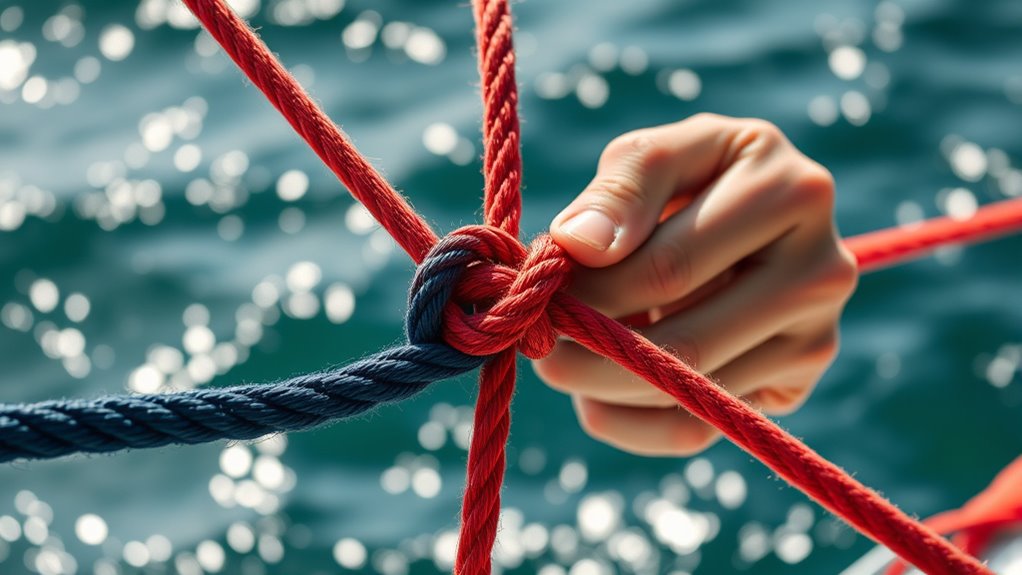
After mastering the clove hitch for secure anchoring, you might encounter situations where you need to join two lines of different sizes or materials. That’s when the sheet bend becomes your go-to knot. It’s simple, strong, and reliable for connecting lines in various conditions. To tie it, form a bight in the thicker or more flexible line, then pass the end of the thinner line under the bight, around both parts, and then back under itself. Tighten the knot to ensure it holds firm. Using a self-watering plant pot analogy can help visualize how the knot distributes tension evenly across different materials, much like trust issues can affect the strength of a relationship. The sheet bend is also valued for its ability to maintain strength even when the lines are subjected to dynamic loads such as shifting or movement. Properly securing the knot ensures it remains reliable under stress and prevents slipping during use.
Remember:
- Use a sheet bend for lines of different diameters or materials.
- Keep the ends visible for easy inspection.
- Test the knot before trusting it with any load.
- A secure connection is essential for safety and performance at sea.
The Double Fisherman’s Knot: Reliable for Heavy Loads

If you need a knot that can handle heavy loads securely, the Double Fisherman’s Knot is an excellent choice. This knot creates a strong, reliable connection between two lines, especially when you’re dealing with thick or high-tensile ropes. To tie it, you make a double overhand knot with each line around the other, then pull tight to snug the knots together. It’s particularly useful for securing a loop in a line or joining two lines for heavy lifting or towing. The Double Fisherman’s Knot is resistant to slipping under tension and maintains its strength even under load. Just ensure you dress and tighten the knot properly, and it will hold firm in demanding sailing situations. It’s a go-to knot for durability and security. Additionally, knowing about the cost of electric bikes can help you choose the right gear for your sailing adventures, especially if you need portable power sources on board. Understanding projector contrast ratio can also help you select equipment that ensures clear visibility in your boat’s lighting conditions, enhancing your overall experience.
The Reef Knot: Simple and Effective for Tying Lines

The Reef Knot, also known as the Square Knot, is a straightforward and reliable way to tie two lines together for everyday sailing needs. It’s quick to learn and holds well under steady tension, making it perfect for securing sails or tying off lines temporarily. To tie it correctly, you cross one end over the other, then tuck the end around and through the loop, creating a symmetrical knot. When used properly, it’s easy to untie even after tightening. Keep in mind, it’s not suitable for heavy loads or critical safety applications. You’ll find it handy for tasks like:
- Securing sails or gear temporarily
- Joining ropes of similar thickness
- Tying bags or bundles on deck
Mastering the Reef Knot ensures your sailing experience stays smooth and efficient. Additionally, understanding knot reliability can help you choose the best knots for different situations on your vessel. Recognizing the importance of digital literacy in modern sailing can also improve your navigation of technology onboard. Being aware of the regional maritime practices can further enhance your seamanship skills and safety. Developing a good understanding of industry standards can support safer and more effective knot selection and usage.
The Rolling Hitch: Adjusting Line Tension
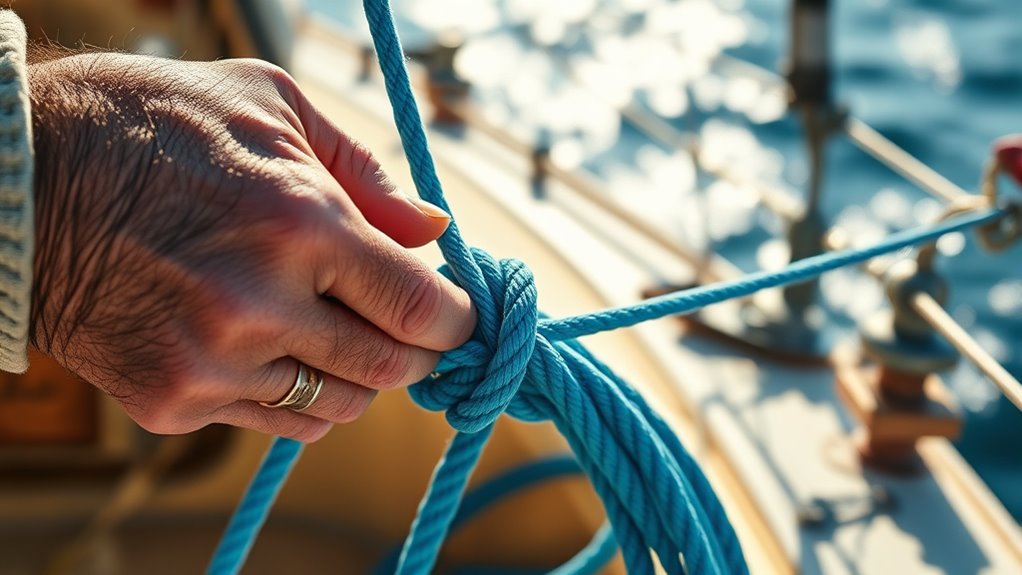
When you need to secure or adjust the tension of a line without untying it, the Rolling Hitch is an invaluable knot. It allows you to tighten or loosen a line easily while remaining secure under load. To tie it, wrap the line around the post or object, then pass the working end around the standing part twice, crossing over the previous wraps. Finish with a half hitch around the standing line. The knot grips tightly when tension is applied but can be adjusted when needed. It’s perfect for controlling tension on sheets, halyards, or dock lines. With some practice, you’ll find it quick to tie and reliable under various conditions. Mastering the Rolling Hitch ensures you can fine-tune line tension efficiently, keeping your boat under maximum control. Additionally, understanding the role of generative AI in entertainment can inspire innovative ways to learn new knot-tying techniques through interactive tutorials.
The Figure-Eight Knot: Safety and Stopping Point
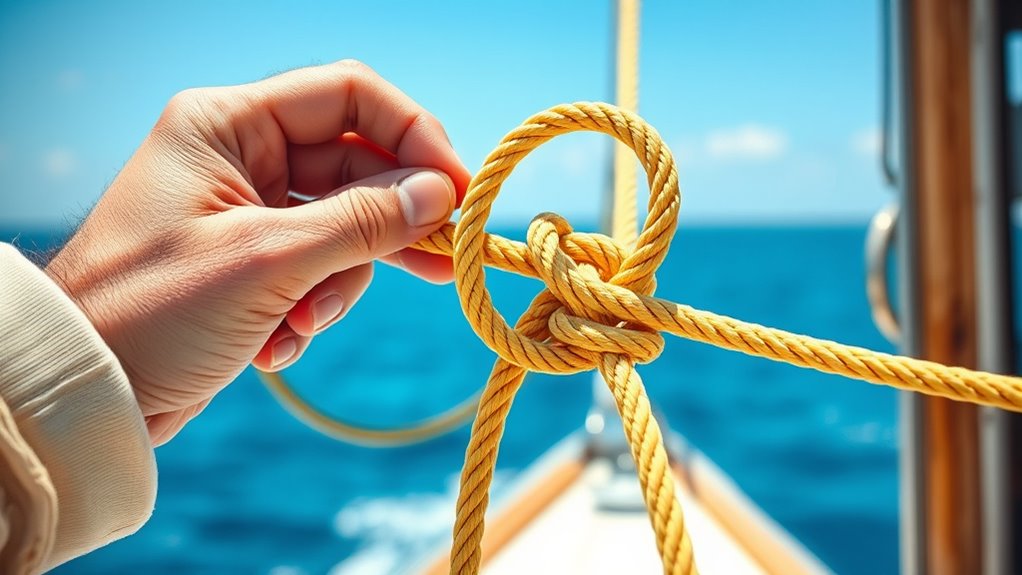
The Figure-Eight Knot serves as a reliable stopper and a safety stop point in sailing applications. It prevents ropes from slipping through blocks, cleats, or fittings, ensuring your lines stay secure. When you need a dependable stopper, this knot is quick to tie and easy to recognize. It’s especially useful when adjusting sails or securing lines that require frequent adjustments. Additionally, practicing support skills like understanding PlayStation Support Hours can help ensure you’re prepared for any technical issues that may arise during your sailing or leisure activities. Incorporating AI-driven content optimization techniques can further enhance your understanding of effective knot usage and safety measures. Recognizing the importance of conflict resolution in maintaining a harmonious sailing environment can also improve overall safety and crew coordination. Understanding ethical hacking principles can remind us of the importance of anticipating vulnerabilities and securing our equipment, much like securing your lines with a figure-eight knot. Moreover, mastering fundamental knots like the figure-eight can contribute to your overall sailing safety and confidence on the water.
Frequently Asked Questions
How Do I Choose the Right Knot for Different Sailing Conditions?
When choosing the right knot for sailing conditions, consider the task at hand and the load it will bear. For securing lines in strong winds, opt for sturdy knots like the bowline or figure-eight. If you need quick release, go for a cleat hitch or bowline. Always match the knot to the purpose—whether for securing, joining, or adjusting—to guarantee safety and efficiency on the water.
What Are Common Mistakes to Avoid When Tying These Knots?
When tying sailing knots, you wanna avoid common mistakes like not tightening them properly, which can cause slipping. Always check for secure, snug fits, and don’t rush through the process—take your time to guarantee each knot is correct. Also, make sure to use the right knot for the job, as using the wrong one can lead to failure under stress. Practice regularly to develop confidence and precision.
How Often Should I Inspect and Replace Sailing Knots?
Like a seasoned sailor checking their compass, you should inspect your sailing knots regularly, ideally after each trip or when they’re exposed to harsh conditions. Look for signs of wear, fraying, or slipping, and replace them as needed. If a knot shows any weakness, don’t hesitate—safety’s at stake. Consistent inspection keeps your gear reliable and guarantees smooth sailing, just like a trusted crew member.
Can These Knots Be Tied in Wet or Icy Conditions?
You can tie these knots in wet or icy conditions, but you should exercise caution. Wet ropes can be slippery, making knots harder to secure properly, so make certain you tighten them well. In icy conditions, the rope may become brittle, risking breakage, so check the strength before relying on the knots. Practice tying knots in different conditions to build confidence and ensure safety during your sailing adventures.
Are There Alternative Knots for Specific Sailing Tasks?
When you look for alternative knots for specific tasks, you find that different knots excel in various situations. For example, a bowline creates a secure loop that’s easy to untie, perfect for cleats or rescue situations. A sheet bend is great for joining ropes of different diameters. By understanding each knot’s strengths, you can choose the best one for your needs, enhancing safety and efficiency on your sailboat.
Conclusion
Mastering these knots isn’t just about quick fixes on the water; it’s about building trust in your skills and understanding that even the strongest lines need a gentle touch sometimes. As you weave these knots into your sailing routine, you’ll discover that patience and practice create a silent assurance, guiding you safely through calm and storm alike. Remember, every knot you learn is a quiet promise to keep your journey steady and secure.



